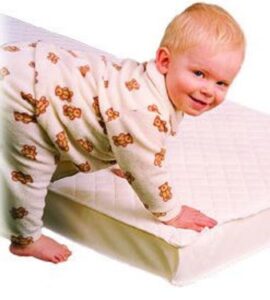Sing Your Little One To Sleep With An Organic Baby Mattress

Choosing a non-toxic baby mattress that’s made without all of the chemicals associated with conventionally-constructed mattresses is an important step if you want your child to sleep in a healthy environment. But it’s even more difficult if you also want to choose one that’s good for the environment.

Cotton is a common material used to construct mattresses—both large and small. And while cotton may seem like a “natural” material that would be inherently good for the planet and baby, it relies heavily on synthetic agricultural chemicals like insecticides and pesticides. There are three main causes of cotton’s bad environmental reputation: chemical pesticide and fertilizer use, water consumption, and dyes. Let’s address them one by one.
First, there is the use of powerful synthetic chemicals to grow conventional cotton crops—from pesticides to herbicides to fertilizers. Cotton makes up only about 2.4 percent of the cropland cultivated around the world, and yet it consumes 24 percent of all insecticides and 11 percent of all pesticides worldwide!
More than half of these chemicals are classed as hazardous by the World Health Organization (WHO). Not only do they harm the pests they’re targeting, the also kill beneficial insects, microorganisms, and plants. They also create widespread pollution, killing wildlife, including livestock, fish, and birds. Organically-grown cotton, on the other hand, is grown in soil that has to have been free of these toxic chemicals for a minimum of three years, and will be identifiable as organic by the USDA “Certified Organic” label.
Second, cotton requires huge quantities of water. It is estimated that 1,800 gallons of water are used to grow enough cotton for a pair of jeans—water that could otherwise be used to grow food and nourish drought-stressed regions at home and abroad. While organic cotton doesn’t solve the problem of water consumption, at least you can be assured that the water used on organic cotton crops isn’t contaminated with agricultural chemicals.
Third, cotton is most often treated with synthetic coloring agents and whiteners to achieve a desired look, even for cotton used in mattresses. Cotton is extremely resistant to dyes, with about half of that applied to it simply washing out into our fresh water supplies where it is hazardous to groundwater and wildlife. That’s because it contains toxic petrochemical-based and heavy metal ingredients like mercury, chromium VI, lead, arsenic, and cadmium.
An organic baby mattress will be free of these dyes—it will either be un-colored altogether, or it will make use of earth-friendly dyes. Safe dyes are those that are plant-based. Alternatively, organic cotton may be color-grown, which means the color is part of the plant’s natural appearance.
The added benefit of choosing an organic baby mattress is that it much healthier for your baby. Here’s why:
- If the WHO believes many agricultural chemicals are hazardous, should we really be using them on materials for our baby mattresses? Organic cotton mattresses ensure your baby won’t be exposed to such chemicals.
- Babies can have chemical sensitivities to dyes, resulting in respiratory and dermatological allergies. And some dyes are believed to be carcinogenic. Plant-based dyes shouldn’t cause these problems.
So in addition to looking for a safe, non-toxic baby mattress and organic bedding you may also want to consider choosing one made from organic cotton, for the health of your baby and the planet.
Want more green living tips to create a healthy home for you and your family ? Sign up for the OrganicAuthority.com newsletter and get your free reportHow to Shop forOrganic Foods on a Budget, broughtto you by Laura Klein Green Living Expert.

